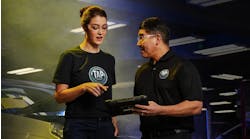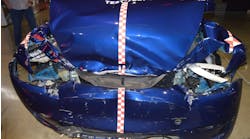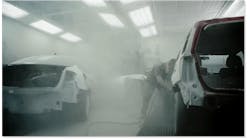In this article, we will explore some ways to apply lean principles to refine your quality assurance processes. These quality assurance processes enable a review of each process in the repair cycle to assure it is done to the proper standard, and is reviewed against this standard, prior to moving to a downstream process. The end goal is the repair center ultimately delivers a repair in the “same shape and form” as the OEM standard and the customer experience is legendary.
QC Checklists Aren’t the Only Answer
Most repairers establish “quality control” forms and hope that the product of the repair and repair experience can pass their “QC checklist.” Having a form has proven somewhat useful, as it forces everyone in the repair process to verify quality against a checklist the shop may have gotten at a seminar or online, and not an agreed upon standard. Unfortunately, you hope the repair quality (and repair experience) passes the QC checklist, achieves high CSI, and generates a solid NPS score. But in a lean practitioner’s mind, “Hope is not a strategy.” The rest of this article lays out a possible strategy.
Quality Assurance Instead
Lean practitioners instead implement a more involved “quality assurance” system to implement the building blocks of quality into a repair process. They generally start with a quality statement. The quality statement we created while at ABRA Auto Body and Glass was “Right the first time, on time.” That statement implied that fixing it right the first time was a higher priority than speed, profit or any other measure.
Fundamental to quality assurance is information.
Information on the estimate to prove all the parts and repair procedures are documented. Information from the OEM equipment manufacturer on how they recommend completing the repair. Information from I-CAR and industry training sources on how to properly complete a repair. Information from the tool, equipment, and suppliers of consumables on how to best use their products performing the repair. And information on the customer’s needs and wants to assure you are delivering an experience which reflects their concerns and what they value.
Technician Advisory Groups Craft Quality Standards
With many organizations I have been a part of managing or have consulted with, we have formed a technician advisory group which meets periodically and crafted a set of interdepartmental standards which delivered on this promise. We use a flip chart and define these with Post-it notes to allow us to reposition the statements as they evolve. We always have someone from the downstream departments in the discussion, as they see the workmanship and the challenges they face and share them to craft the best standard. These standards were called quality standards, and they define the five to eight most critical things to assure were complete, PRIOR to moving a vehicle, file, or customer experience through the process.
Here is an example quality standard from body to paint:
- Frame repairs specifications before and after are in the working RO file.
- Mechanical systems have been, at minimum, diagnosed and (if possible) repaired prior to completion of the body repair process, so parts or unknowns don’t cause delays.
- All welds have been finished off and caulking and seam-sealing of the vehicle and parts have been completed.
- The inside of all installed panels has been painted on both sides and gaps verified and lights and attached emblems pre-fitted to avoid work after paint.
- As much of the reassembly has been done as possible to enable final reassembly in two hours or less.
- Filler has been cured with a GFS REVO (or similar drying device) to fully cross-link filler prior to primer.
- “Primer-ready”: All body work is finished in 320 grit with a 3-6” featheredge, and the surface is ready to be primed.
So, if the technician helped craft these standards and new hires are trained on them up front, they work during the repair to ASSURE they are completed prior to passing to the downstream department. The concept of “primer-ready” came from a technician in Madison, Wisconsin, who said, “The reason I don’t worry too much about the final sanding standard is because a prepper always uses the DA on the repaired surface prior to paint, and they may take off more material. If you want it “primer-ready,” trust what we do and prime it!” This was a game-changer for the shop.
Another technician, after hearing about the new primer-ready standard, said, “But, we aren’t getting paid for that.” It turns out that is NOT true, as the paint times are for a new undamaged panel. There is no time in the crash guide for block and prime in paint times. Therefore, the body times (judgment times) for repair have time allocated to the body tech to make the repair in the same shape and form as a new, undamaged OEM panel. Asking body techs to get a surface primer-ready is actually one part of completing the body repair.
Shops have chosen to have the paint team apply primer and block it to prep for paint without compensation. They do it, as the final blocking is similar to checking the OEM panel for imperfections prior to painting both sides.
Once we agreed to this standard, there were far fewer discussions about body repair quality and unknowns.
And then, Work Standards
Next, the technician advisory group was asked to define the work standards or standard work to ensure these quality standards are achieved 100% of the time. The focus on these standards is what are the steps or work standards which are “critical to quality” to achieve the quality output desired. These step-by-step instructions are high level, and they detail the key steps to achieve these standards. Here again, we limit the number of steps to 10-15 to avoid overcomplication.
Example Work Standard for checking in a vehicle:
- Greet customer by name (if possible), based on daily incoming vehicle schedule.
- Ask for and tag their key (have the tag pre-filled out in advance).
- Ask them to review the payment policy and sign the work authorization.
- If not on-site, call, text or email the rental agency to assure they arrive promptly.
- Ask them to go to the vehicle to “review what we are repairing” and point at the major components you will be repairing.
- Take a final opportunity to sell them on repairing the things that will add value to their vehicle (often referred to as up-sells) “while you’re here.”
- Provide a brief explanation of the repair process and reinforce the fact that you will call them later that day once you have fully disassembled the vehicle and written and accurate plan of the repairs we will be performing. At that time, we can estimate the expected delivery date.
- Ask them how they would like to be communicated with during the repair process – text, email, or phone call? Generally, we do this before 10 a.m. Is that a convenient time for them?
- Thank them and pull the vehicle in the pending pre-wash / pre-scan area.
Work Instructions prevent too much detail in Work Standards
The detailed steps on how to use a tool, or how to perform a task, are saved for “work instructions,” and those are posted at the point of use, or available on the cart near the supply (or made available online like the 3Mcollision.com site). As new pieces of equipment or tools are purchased, ask the supplier to provide these work instructions on use and maintenance, so they can be referred to for new hires or reviewed (if necessary) by the technicians using them.
These quality standards can be refined to use a Disney University process where you show a “good-show” and “poor-show” view. In a Disney theme park, they use visual management to show the difference between dressing in the Disney costume correctly versus incorrectly (long beard, tattoo showing, or other concerns). So, if it adds value, showing images of the standards when they are formalized can be quite valuable.
These standards often are posted on the shop floor on the original flip chart you used when they were created. This allows reviews during the first couple weeks after they are established AND when a quality control failure occurs to see where in the work standard, we didn’t follow the process or what they didn’t verify when reviewing the quality standard before moving the vehicle up stream. Periodically, a “Spot Kaizen” or continuous improvement discussion happens at that moment and a standard need to be improved to prevent the quality issue in the future. These quality errors should also be logged in a continuous improvement log to reinforce the frequency and need for training on the work standard or reinforce the thoroughness of their final quality control inspections.
Forming the Habit of Following the Standards
If these processes are put in place, and reinforced for sufficient time to become a habit, then the need for a manager to inspect for quality assurance between departments. Remind the team you expect “perfection” and want them to pause and review their work PRIOR to moving it outside or to the downstream function. It is crucial that you make the downstream department aware of these quality standards so they can double-check as necessary. The company culture needs to be cultivated so that if they see something that is missed, they can reject the repair and send it back to the downstream department to “get it right” without being ostracized for pointing out things that are not right.
Final Quality Inspection
Finally, an important quality control inspection needs to happen prior to delivery, this one by the estimator or customer advisor. They listened to the customer’s wants and needs, so they need to verify the repair and repair experience meet their expectations. In short, in Toyota’s words, we trust our interdepartmental quality checks, but we “never let the end customer be the final quality control.” We strongly reinforce this to avoid rework or adjustments later that would cause CSI/NPS concerns.
In summary, establishing a quality assurance system is founded on getting technician/staff input on setting the quality standards for work to transition between departments, then work standards which are critical to quality are refined to assure the necessary steps are taken. Then, these standards are put in place and reinforced until they become a habit and then we trust the staff to become the quality inspector of their own work prior to movement up stream. Then, finally, get the estimator to perform the final inspection to verify quality is assured!



